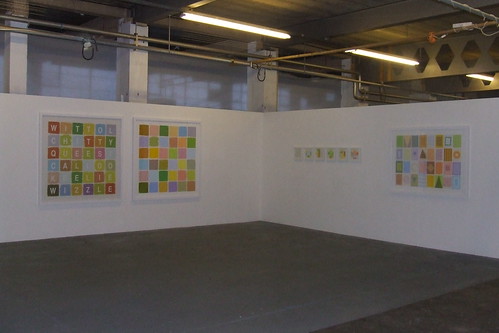Six Birds of the Coquet Valley, Northumberland by Mike Collier and shown in the Hanging Wall
Image by Topsy@Waygood
Brief Biography
Mike Collier is a lecturer, writer, curator and artist. After completing the Foundation Course in Liverpool, he studied Fine Art at Goldsmiths College (University of London) in the mid 1970's before being appointed Gallery Manager at the ICA in London.
He subsequently became a freelance curator and arts organiser, working extensively in the UK and abroad. In 1985 he moved to Newcastle to run the Arts Development Strategy at the Laing Art Gallery, where he initiated the Tyne International Exhibition of Contemporary Art.
For the last 15 years he has worked in education and is currently Programme Leader for Foundation Studies in Art and Design at the University of Sunderland, where he also teaches students on the MA in Curating course.
Throughout his working life, he has patiently developed his own practice.
Below is the statement by Mike Collier that accompanied this work in the Hanging Wall.
My work draws its inspiration from the simple act of walking. The experience of walking crosses social and cultural boundaries. It is arguably one of the most egalitarian ways in which we can perceive the world in all its richness and complexity. It is an embodied experience and reminds us that people are part of nature.
The recent history of walking has its roots in working class rebellion. In the 19th Century, urban walkers from the northern industrial cities were amongst the first groups of people to challenge the view that rights of property in the countryside were absolute. In the 20th Century, approaches to organised have combined the romantic tradition of Coleridge, Wordsworth, Muir and Ruskin with earlier modes of cultural marching (like the Orange Parades in Ulster) to take direct political action through walking, mounting successful political demonstrations (eg the Jarrow Crusade and the mass trespass of Kinder Scout in 1932).
When I am walking , I am interested in exploring the interrelated nature of ecological and cultural ideas through a detailed study of local environments and our engagement with "landscape".
The historical layering of our environment is tied to an understanding of language through the naming of places and species. The names of many places and species have local derivations and these names often refer to our senses (sight, sound, taste, touch and smell) in a way that current language does not.
This current piece is called Six Birds of the Coquet Valley, Northumberland. A study of bird names presents an "unpredictable and haphazard richness" with names drawn from "the very roots of our language" British Birds: Their Folklore, Names and Literature by Francesca Greenoak. The name Coquet comes from the old English coco, meaning "wild bird".
WITTOL Wheatear
CHITTY Meadow Pipit
QUEEST Woodpigeon
CALLOO Curlew
KEELIE Kestrel
WIZZLE Dipper
Six Birds of the Coquet Valley, Northumberland by Mike Collier and shown in the Hanging Wall
Image by Topsy@Waygood
Brief Biography
Mike Collier is a lecturer, writer, curator and artist. After completing the Foundation Course in Liverpool, he studied Fine Art at Goldsmiths College (University of London) in the mid 1970's before being appointed Gallery Manager at the ICA in London.
He subsequently became a freelance curator and arts organiser, working extensively in the UK and abroad. In 1985 he moved to Newcastle to run the Arts Development Strategy at the Laing Art Gallery, where he initiated the Tyne International Exhibition of Contemporary Art.
For the last 15 years he has worked in education and is currently Programme Leader for Foundation Studies in Art and Design at the University of Sunderland, where he also teaches students on the MA in Curating course.
Throughout his working life, he has patiently developed his own practice.
Below is the statement by Mike Collier that accompanied this work in the Hanging Wall.
My work draws its inspiration from the simple act of walking. The experience of walking crosses social and cultural boundaries. It is arguably one of the most egalitarian ways in which we can perceive the world in all its richness and complexity. It is an embodied experience and reminds us that people are part of nature.
The recent history of walking has its roots in working class rebellion. In the 19th Century, urban walkers from the northern industrial cities were amongst the first groups of people to challenge the view that rights of property in the countryside were absolute. In the 20th Century, approaches to organised have combined the romantic tradition of Coleridge, Wordsworth, Muir and Ruskin with earlier modes of cultural marching (like the Orange Parades in Ulster) to take direct political action through walking, mounting successful political demonstrations (eg the Jarrow Crusade and the mass trespass of Kinder Scout in 1932).
When I am walking , I am interested in exploring the interrelated nature of ecological and cultural ideas through a detailed study of local environments and our engagement with "landscape".
The historical layering of our environment is tied to an understanding of language through the naming of places and species. The names of many places and species have local derivations and these names often refer to our senses (sight, sound, taste, touch and smell) in a way that current language does not.
This current piece is called Six Birds of the Coquet Valley, Northumberland. A study of bird names presents an "unpredictable and haphazard richness" with names drawn from "the very roots of our language" British Birds: Their Folklore, Names and Literature by Francesca Greenoak. The name Coquet comes from the old English coco, meaning "wild bird".
WITTOL Wheatear
CHITTY Meadow Pipit
QUEEST Woodpigeon
CALLOO Curlew
KEELIE Kestrel
WIZZLE Dipper
Six Birds of the Coquet Valley, Northumberland by Mike Collier and shown in the Hanging Wall
Image by Topsy@Waygood
Brief Biography
Mike Collier is a lecturer, writer, curator and artist. After completing the Foundation Course in Liverpool, he studied Fine Art at Goldsmiths College (University of London) in the mid 1970's before being appointed Gallery Manager at the ICA in London.
He subsequently became a freelance curator and arts organiser, working extensively in the UK and abroad. In 1985 he moved to Newcastle to run the Arts Development Strategy at the Laing Art Gallery, where he initiated the Tyne International Exhibition of Contemporary Art.
For the last 15 years he has worked in education and is currently Programme Leader for Foundation Studies in Art and Design at the University of Sunderland, where he also teaches students on the MA in Curating course.
Throughout his working life, he has patiently developed his own practice.
Below is the statement by Mike Collier that accompanied this work in the Hanging Wall.
My work draws its inspiration from the simple act of walking. The experience of walking crosses social and cultural boundaries. It is arguably one of the most egalitarian ways in which we can perceive the world in all its richness and complexity. It is an embodied experience and reminds us that people are part of nature.
The recent history of walking has its roots in working class rebellion. In the 19th Century, urban walkers from the northern industrial cities were amongst the first groups of people to challenge the view that rights of property in the countryside were absolute. In the 20th Century, approaches to organised have combined the romantic tradition of Coleridge, Wordsworth, Muir and Ruskin with earlier modes of cultural marching (like the Orange Parades in Ulster) to take direct political action through walking, mounting successful political demonstrations (eg the Jarrow Crusade and the mass trespass of Kinder Scout in 1932).
When I am walking , I am interested in exploring the interrelated nature of ecological and cultural ideas through a detailed study of local environments and our engagement with "landscape".
The historical layering of our environment is tied to an understanding of language through the naming of places and species. The names of many places and species have local derivations and these names often refer to our senses (sight, sound, taste, touch and smell) in a way that current language does not.
This current piece is called Six Birds of the Coquet Valley, Northumberland. A study of bird names presents an "unpredictable and haphazard richness" with names drawn from "the very roots of our language" British Birds: Their Folklore, Names and Literature by Francesca Greenoak. The name Coquet comes from the old English coco, meaning "wild bird".
WITTOL Wheatear
CHITTY Meadow Pipit
QUEEST Woodpigeon
CALLOO Curlew
KEELIE Kestrel
WIZZLE Dipper
No comments:
Post a Comment